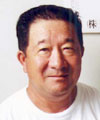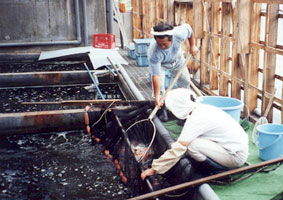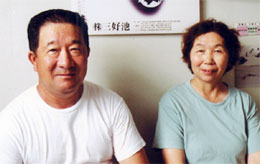
Featured Breeder
Seiji (Seijuro) Suzuki (Suzusei Koi Farm) |
 |
The Suzuki family is the head of a historic family whose ancestors served as shoya *1 The family has lived in Junidaira, Ojiya City for over 800 years until the earthquake that struck in 2004. The Nishikigoi business was started in full-scale by Seijuro Suzuki’s (father of present representative) generation, and they achieved fame for their Showa Sanshoku.
Since their house was located in the center of the disaster site, they currently live in shelters but still are passionate and dedicated to the study of Showa Sanshoku.
|
 The Suzuki family is the head of a historic family whose ancestors served as shoya (Public officers in the Edo Era (1607-1867) who represented the villages and served as a liaison between the village and the government. They controlled taxation, public security, census, and administration issues). The family has lived in Juunidaira, Ojiya City for over 800 years until the earthquake that struck in 2004. The Nishikigoi business was started in full-scale by Seijuro Suzuki’s (father of present representative) generation, and they achieved fame for their Showa Sanshoku. The Suzuki family is the head of a historic family whose ancestors served as shoya (Public officers in the Edo Era (1607-1867) who represented the villages and served as a liaison between the village and the government. They controlled taxation, public security, census, and administration issues). The family has lived in Juunidaira, Ojiya City for over 800 years until the earthquake that struck in 2004. The Nishikigoi business was started in full-scale by Seijuro Suzuki’s (father of present representative) generation, and they achieved fame for their Showa Sanshoku.
Since their house was located in the center of the disaster site, they currently live in shelters but still are passionate and dedicated to the study of Showa Sanshoku
.

We are a descendant of kuge*2 from the Kamakura Era (1192-1333), and my ancestors served as shoya in Junidaira. This is a picture of a jutte*3 that was actually used back then. The head of the Suzuki family succeeds the name “Seijuro”, and I am the 30th generation. We were forced to move to another place after last year’s earthquake, but up until then my family lived in Junidaira for 800 years. Now our farm is called Suzusei Koi Farm, but my father first started the Koi farm as “Seijuro” in 1948. When I was 19, I took part in the Bishamonten *4 Coming home from the festival, I encountered the most wonderful male Showa Koi. I asked for the price, and they told me it cost 300,000 yen (approx. USD2700) in a time when monthly wages didn’t even reach 10,000 yen (approx. USD90). But I wanted it so badly that I went home and talked with my father. We called the bank immediately, and the bank brought us the money early next morning. The final buying price for the Koi was 350,000 yen (approx. USD3200), but I remember clearly how happy I was to have gotten that Koi. Afterwards, we bought back the female Showa that we had sold to our relatives. These 2 Koi are the origin of the Seijuro Showa Sanshoku. The Seijuro Showa Sanshoku wouldn’t have existed if it weren’t for these 2
Koi. It has become more difficult to maintain pure genealogy since we now bring in Koi from other farms, but bloodlines of these 2 Koi still remain strong. My Showa Sanshoku has thin skin, beautiful sumi, and a velvet shiroji with a gentle touch. Of course Koi with thicker skin grow bigger, but I focus more on appearance than size. I don’t let my Koi get bigger and bigger; I want to product beautiful Koi with thin skin.

I also breed Beni Kumonryu and Ginrin Showa for international Koi lovers to enjoy. I currently do not breed Beni Kumonryu, but they were highly appraised by many people. When first making Beni Kumonryu, my mentor, Mr. Hiraishi, gave me some advice; “when making Kawarimono use Shusui spawn, and when making Wagoi use Asagi spawn.” So I crossed a male Beni Kumonryu and a female Shusui and got a fairly nice Koi, but it seemed to be rather plain. At the time I tried to popularize this type of Koi among Koi lovers who like such plain charms, but it didn’t work out. Then I changed directions and decided to make flashy Beni Kumonryu. I crossed a Doitsu Kohaku, and as a result, I got a Beni Kumonryu with splendid red and black patterns. I finally was able to produce Koi that satisfied Koi lovers looking for boldness in Nishikigoi.
 One day Mr. Isa and Mr. Hosokai told me that “Koi need to rest on Sundays as humans do.” So I gave them a day off during a week, which resulted in good egestion of food, lots of movement, and a good physical condition. Now I am thinking of giving them 2 days off. I really appreciate the advices from my mentors and the people around me. However, I also understand that I shouldn’t depend too much on them. When I had problems in producing Beni Kumonryu, Mr. Hiraishi told me “to think for yourself.” Koi, just as humans, are living creatures. There is always a reason for them getting fat, skinny or sick. To make good Koi, you need to observe closely, think and keep studying them daily. I challenged many things in my past; there were times when it took me 10 years to make a Koi. One day Mr. Isa and Mr. Hosokai told me that “Koi need to rest on Sundays as humans do.” So I gave them a day off during a week, which resulted in good egestion of food, lots of movement, and a good physical condition. Now I am thinking of giving them 2 days off. I really appreciate the advices from my mentors and the people around me. However, I also understand that I shouldn’t depend too much on them. When I had problems in producing Beni Kumonryu, Mr. Hiraishi told me “to think for yourself.” Koi, just as humans, are living creatures. There is always a reason for them getting fat, skinny or sick. To make good Koi, you need to observe closely, think and keep studying them daily. I challenged many things in my past; there were times when it took me 10 years to make a Koi.
My advice to all Koi lovers is to study your pond, study others’ ponds, and keep thinking what you can do best to raise good Koi.
|
|



